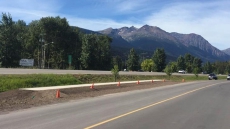To coincide with the start of the school year and remind drivers of the return of 30 km/hr school zone speed limits, the Delta Police Traffic Section will be targeting all Delta schools over a 10 day period, starting on September 6th.
Officers will be focusing on speed in school and playground zones, seatbelts, yielding to pedestrians and school buses, and other motor vehicle act offences.
Every school day, unless otherwise posted, a 30 km/hr speed limit is in effect in school zones from 8am – 5pm. Playground zones signposted with a 30 km/hr speed limit are in effect every day from dawn until dusk.
Fines for speeding in school or playground zones can range from $196-253 depending on the speed, and come with 3 penalty points.
One ticket that will be new to Delta this year is the Positive Ticket. Delta Police will be handing out the positive tickets to youth who are obeying the rules of the road, whether riding, gliding, or walking. The ‘penalty’? A free ice cream from McDonalds!
TIPS FOR DRIVERS FROM ICBC AND POLICE:

Every school day, unless otherwise posted, a 30 km/h speed limit is in effect in school zones from 8 a.m. to 5 p.m;
When you’re dropping off your children in school zones, allow them to exit the car on the side closest to the sidewalk. Never allow a child to cross mid-block;
If a vehicle’s stopped in front of you or in the lane next to you, they may be yielding to a pedestrian, so proceed with caution and be prepared to stop;
Watch for school buses. Vehicles approaching from both directions must stop for school buses when their lights are flashing;
Before getting into your vehicle, walk around your vehicle to make sure no small children are hidden from your view. Always look for pedestrians when you’re backing up;
If in doubt, SLOW DOWN in any areas frequented by children!
TIPS FOR BEING A SAFE PEDESTRIAN:

Plan out your child’s walking route with them ahead of time. Review street names and landmarks;
Teach your child the correct meaning of traffic signs;
Teach your child to always use a marked crosswalk wherever possible, and to always walk across the road not run;
Teach your child to make eye contact with drivers and to ensure all vehicles have stopped before they cross the road, even if the walk signal is on;
Explain to your child the dangers of walking with earphones in or while using an electronic gadget;
Ensure your child is wearing bright, easy to see clothing – especially in bad weather or at night;
Explain to your child the dangers of crossing between parked vehicles as it is harder for drivers to see children;
If your child cycles to school, ensure they know the rules of the road and are wearing an approved helmet. Ensure their bicycle is properly equipped with lights and reflectors and is in good working order.




